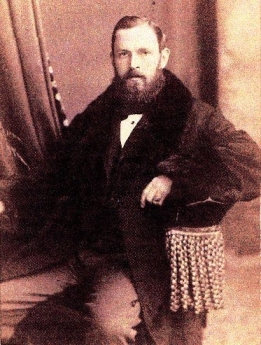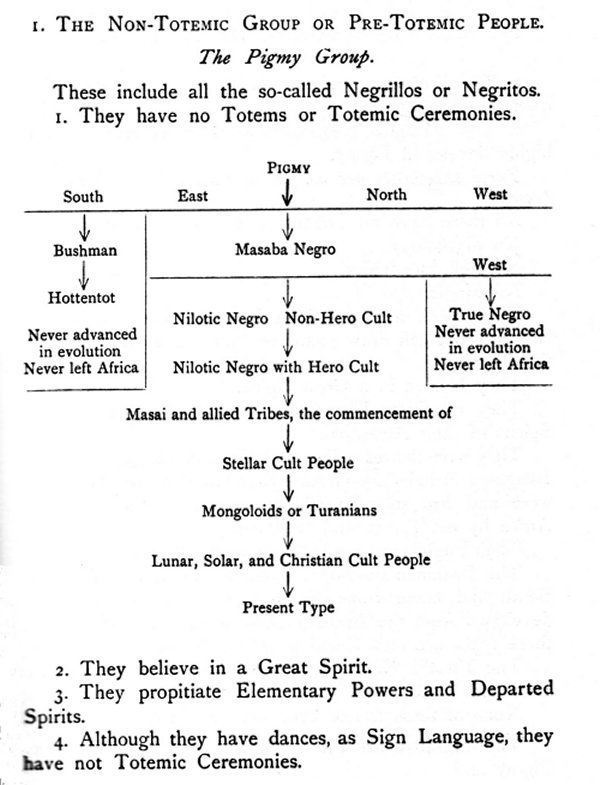|

|
|
Dr. Albert Churchward
M.D., M.R.C.P., M.R.C.S., F.G.S.,
P.M., P.Z., 30 Degree.
Photo: Courtesy
Jack Churchward. |
The brief descriptive information and diagram below has been adapted from Churchward's
Origin and Evolution of the Human Race (Allen, 1921). It gives more
— and probably clearer — support to Massey's evolutionistic theories on early population migrations out of Africa, and Churchward extends his theories from his earlier
Signs and Symbols of Primordial Man (1910) to deal more specifically with this subject. As a medical doctor he considers human anatomical and physiological characteristics, as well as various types of worship, beliefs, customs and symbols. An abridged version of his theories also with diagrams and illustrations was given as a lecture in 1912, and published as
The Origin and Evolution of Primitive Man (Allen, 1912).
As with Massey's trilogy, it is necessary to
recognise the dates the books were written, and to read them within the
context of the findings of modern research. |
|
AGE AND ORIGIN OF PRIMARY MAN
PALÆOLITHIC
(c. 2.5 million - 10,000 years BC)
Original or Primary Man
|
|
The Non-Totemic group or Pre-Totemic people.
The Pygmy
Group (which includes all the so-called Negrillos or Negritos). |
|
>
They have no Totems or Totemic ceremonies.
> They believe in a Great Spirit.
> They propitiate Elementary Powers and Departed Spirits.
> Although they have dances, as Sign Language, they have no Totemic
Ceremonies.
> They have no written language, but speak a monosyllabic language,
and have a Sign and Gesture Language.
> They have no Mythology or Folk-lore Tales.
> They have no Magic.
> They have no Initiatory rites.
> They have no Tribal markings.
> They have limited primitive implements. |
|

|
|
The Second or
Sub-Group, Descendents of the Pygmies are:—
1.
The Bushmen, and the Hottentots who descended from them.
2. The Masaba Negroes who were evolved from a highly developed
Pygmy.
These sub-classes are not found outside Africa - past or present. |
|
>
All these have no Totems or Totemic Ceremonies.
> No Mythology.
> No Folk-lore Tales.
> No Magic.
> They speak a monosyllabic language, have no written language but can
draw pictures - Signs and Symbols like the Pigmy.
> They believe in a Great Spirit.
> They propitiate Elementary Powers, or Spirits, and the Spirits of their
Ancestors.
> They have dances - Sign and Gesture Language. Sign Language includes
the Gesture Signs to which the Mysteries were, and are still, danced or
otherwise dramatised in Africa by the Pigmy and Bushmen.
> Their implements are the same as the Pigmy - primitive.
The Bushman (1) developed from the Pigmy and travelled South and never came North again, and the Hottentot developed from the Bushman and also never came North. These types are only found in South Africa.
The Masaba Negro (2) developed from the Pigmy North, East and West.
None of these are or ever were Anthropophagous.
The Masabas are the connecting links between the Pigmy and:
|
|
The Third Group - The Totemic
People.
All these have Totams and Totemic Ceremonies and are, or were at one time, Anthropophagous.
They are divided into two distinct groups:
1.
The True Negroes.
These were developed from the Masaba in the West, and have distinct anatomical features from the Nilotic Negroes - they never left Africa except as slaves.
2. The Nilotic Negroes.
They can be divided into two distinct classes; a lower type, and a higher type, the latter developed by evolution from the former, each being identified thus:
a) The Lower Class.
They have no Mythology.
They have no Hero Cult.
They have no Tattoo.
They raise, however, marks on the skin - Cicatrices.
b) The Higher Class.
They have Mythology.
They have Hero Cult.
They have Tattoo.
Both have Magic, Totems and Totemic Ceremonies. |
|
The descendants of former exodes of these Nilotic Negroes can still be found in many countries. They followed the Pigmy, exterminated him in some places and drove him into more inaccesible spots in others. But the osteo remains of both are found in many parts of the world in different strata, and types of both are still extant in various countries. All the above may be classed as Palæolithic. |
|
NEOLITHIC
(c. 10,000 - 3,000 yrs BC) |
|
From the Nilotic Negroes were developed
The Fourth Group, Turanians and Mongoloid - primary.
The Stellar Mythos
People.
They spread over Europe and Asia except the extreme North; North and South America except the extreme North and South; some Isles of the Pacific and throughout Africa. They have left indelible proofs of their great skill and learning which may be judged by the many great cities and finished blocks of stone that are still to be found in Africa, Central and South America and other places.
There are no traces of these people in Australia, New Guinea, New Zealand, the extreme North of Europe, Asia, North America or Patagonia.
Two ages can be identified :
1) The first exodus having Sut or Set for their Primary God. All their first temples are round and orientated South. They buried their dead with their faces to the South.
2) The second exodus - followers of Horus, God of the North. They have all their temples in the form of a double square, end to end, orientated North. They were buried in the 'thrice-bent position' with characteristic amulets, implements etc placed in their tombs. |
|
The Lunar and Solar Cult
People.
After the Stellar, the Lunar and Solar Cult people followed, and various exodes of these left Egypt , but there was much overlapping.
The buildings of the Stellar Cult can be identified separately from those of the Solar people's.
The Stellar were Iconographic, whereas the Solar who followed, were not.
The Stellar's buildings were bonded, the Solar's were not. However, they both built with polygonal shaped stones and with monoliths.
The reason for this was that the Stellar people portrayed their Gods and Goddesses in Zootype forms - all these were pre-human.
In the Solar Cult they had ceased depicting them in Zootype form, and portrayed them in the Human form.
It was at the beginning of the Solar Cult that Har-Ur, the Elder Horus, was depicted as a child in the place of the Lamb - the Fish - the Shoot of the Papyrus plant, etc. There was no human figure personalised in the mythology of Egypt; when the human figure did appear, it ceased to be mythological and became eschatological.
The Solar Cult people spread throughout Europe, except in the extreme North - through the Southern part of Asia, but not North of Asia - to the South of Africa, and from Yucatan (where they landed from Egypt) down to Peru, in a South-westerly direction. No evidence has been found of these people having gone to the extreme North of Europe, North of Asia, or North of America, although evidence may have been destroyed at the time of the Glacial epochs.
In any case, the present inhabitants are pre-Solar people, who must have been driven South more than once by the Glacial period, and then driven North again by the Solar Cult people, who did not follow them so far north.
From the eschatology of the Egyptians, at the downfall of their empire, Christianity was evolved out of the ashes of the Copts and is supposed to be the highest evolution of all the religious cults at the present time. |
|
Note: Following previous
information on migrations of the human species from Africa using mtDNA
(see Massey Biog. ch.9) further
research on the subject has been undertaken by the New York University
of Dentistry. An oral bacterium, Streptococcus Mutans affects most
humans, causing dental caries, and is transmitted from mother to child.
Researchers used DNA markers to differentiate between strains, then
tracing their evolution back to an original African population.
The strains show an exodus to Asia, with a branch from there that
evolved with Caucasians. It is thought that the Caucasian group
may have been founded from some Asians who retraced their footsteps back
to Europe (New Scientist, 18 August 2007, p. 38). |
|
